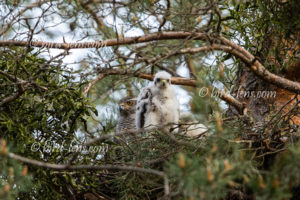 It is said that the best thing about finding the Northern Goshawk (Accipiter gentilis) is to listen to the calls of the offspring. However, none of this was heard during my last visit to a nest with 3 young Northern Goshawks. Nonetheless, the recent inspection was successful.
It is said that the best thing about finding the Northern Goshawk (Accipiter gentilis) is to listen to the calls of the offspring. However, none of this was heard during my last visit to a nest with 3 young Northern Goshawks. Nonetheless, the recent inspection was successful.
After doing some searching on a spring morning, I decided that a large bird in the treetops of a tall pine tree looks very raptor-like. I see that it is actually a young female Northern Goshawk. The tree is only slightly larger than the surrounding pine trees. But it still stands out from the small wood. The Northern Goshawk pair has been breeding in the area for many years now. The important thing now is to visit this reliable place in the right season. Then from mid-June you will see whether the offspring has already left the nest. At this time, the young birds remain in the nest area so that they can continue to be fed by the parents at the former nesting site. The young female hawk wasn’t particularly shy when she realized I had seen her. This way, I could perform some nice images with my Canon EOS 1 DX Mark III.
It was more by chance that I came across a breeding couple near my home town the next year. Not far from the place where live, 3 young Northern Goshawks were spotted a whole morning in mid-July. In early spring a Northern Goshawk called its courtship call from inside a light pine grove. Although I roamed the forest on foot, I couldn’t make out a Goshawk. I visit the beautiful lowlands with its nature quite regularly. But I couldn’t spot a Northern Goshawk during the weeks. At some point I got a tip. The search for the nest is quite difficult. The nest is always very high up in a tree. So here too. Right away, the messy assembled brushwood in a fork in a not so strong pine tree looked anything but promising. Not much droppings had been thrown down either. In any case, the root area of the pine tree showed hints, no abnormalities. Nothing was visible in or on the nest. One day, however, there were 2 small, white feathers to admire. Then, in mid-May, a raptor was clearly sitting in the nest. A Northern Goshawks – probably a female – was confirmed on closer inspection.
Now – 2 weeks later – the youngs can be seen well. A chubby, white ball wobbles uncertainly over the untidily assembled nest. The pile of twigs and branches seemed to have been deserted. Only one or the other white feather let residents guess.
A female Goshawk flies towards its partner somewhere in the pine forest. A short call reveals the male. With a prey in the catch, the female flies back to the nest. When I look up with my binoculars at the nest, the female Goshawk sits in the back of the nest and in front of it clumsily, two, even three young Goshawks frolic. Unfortunately, I could not see the catch being handed over. The lining seems to be already plastered.
One of the young hawks seems to have developed something further. While the other two youngs still have a pure white plumage, this one already has the first dark quills. The young with the dark quills jerks a little on the nest and lifts the wings. Something is still missing, I think. The wing springs have yet to develop.
The long lens on the tripod down there on the forest floor seems to interest the young more closely. The young raptor looks down for a while and stands almost upright on the edge of the nest. The siblings have also risen and seem to want to examine the closer nest area as well. Meanwhile, the mother sits stoically behind her little one and does not seem to be interested in the viewer.
In order to meet the growing demand for top images of the rarer species of Palaearctic Bird-lens.com has specifically made trips to remote places. Additionally every chance is used, if a rare bird is around the homeground. This to do everything to ensure excellent photos of the Birds of the Western Palearctic . The yield of pictures also of rare Western Palaearctic birds is very good. There are other nice images of birds, that you will find behind the tab “Picture Shop“. Just give a notice if you need a picture of a bird which is not online.